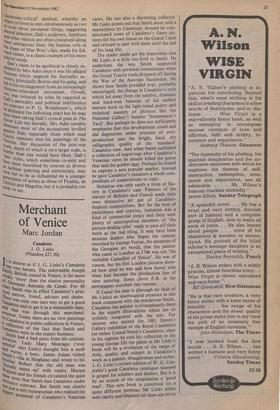Merchant of Venice
Marc Jordan
Canaletto J. G. Links (Phaidon £27.50)
It is almost as if J. G. Links's Canaletto has two heroes. The unloveable Joseph s" mtthh British consul in Venice, is far more osolidly 'there' than the elusive personality , Giovanni Antonio da Canal. For 40 TYe Smith was in effect Canaletto's prin- heePatron, friend, advisor and dealer. e was only one sure way to get a good a'analetto and to get it in a reasonable time, gild that was through this marchand- binaleur. Today there are no view paintings aY Canaletto in public collections in Venice, carenection of the fact that Smith and Qtlaketto were in the export business. ornith had a bad press from his contem- (3,raries, anitefup Lady Mary Montagu ('ever says Links) thought him a .snob "rse, a bore. James Adam visited brother on, 's villa at Mogliano and wrote to his literally Robert that the old man was Walpole eaten up' with vanity. Horace false and his friends circulated the quite e2,e storY that Smith had Canaletto under —41. sive contract. But Smith was clearly ..ot just a wily businessman who realised the export Potential of Canaletto's Venetian
views. He was also a discerning collector. Mr Links points out that Smith never sold a masterpiece by Canaletto. Instead he com- missioned some of Canaletto's finest pic- tures for his own house on the Grand Canal and refused to part with them until the end of his long life. The reader might get the impression that Mr Links is a little too kind to Smith. He underlines the way Smith supported Canaletto with personal commissions when the Grand Tourist trade dropped off during the War of the Austrian Succession. He shows how Smith presided over, probably encouraged, the change in Canaletto's style which led away from the sombre, dramatic and hard-won beauties of his earliest mature work to the light-toned poetry and technical mastery of pictures like the National Gallery's famous 'Stonemason's Yard'. But perhaps he does not sufficiently emphasise that this development could and did degenerate under pressure of over- production into the bright, hard, dry calligraphic quality of the 'standard' Canaletto view. And when Smith published a collection of engravings after Canaletto's Venetian views he almost killed the goose that laid the golden eggs. Perhaps he hoped to capture a new popular market. Instead he gave Canaletto's imitators a whole com- pendium of compositions to copy. Imitation was only rarely a form of flat- tery in Canaletto's case. Painters of the stature of Bellotto and Guardi made their own distinctive art out of Canaletto- inspired compositions. But for the host of pasticheurs and copyists, imitation was a kind of commercial piracy and there were plenty of unscrupulous members of 'the picture-dealing tribe' ready to pass off their work as the real thing. It may have been anxious dealers ho began the rumour recorded by Georg we Vertue, the antennae of the Georgian art world, that the painter who came to London in 1746 was not 'the veritable Cannelleti of Venice'. He was of course, but his first London pictures show- ed how tired he was and how bored with what had become the production line of view painting. Some clever P.R. in the newspapers scotched this rumour.
If Canal the man is (through no fault of Mr Links) an insubstantial presence in this book compared with the ponderous Smith, Canaletto the painter is triumphantly there in the superb illustrations which are so stylishly integrated with the text. For anyone who missed the 1981 Queen's Gallery exhibition of the Royal Canalettos (or rather Consul Smith's Canalettos, since in his eighties he sold his collection to the young George III) the plates in Mr Links's book will be a revelation of the range of style, quality and subject in Canaletto's work as a painter, draughtsman and etcher. J. G. Links's revised edition of W. G. Con- stable's great Canaletto catalogue raisonne is gospel for scholars and dealers. But it is by no stretch of the imagination a 'good read'. This new book is conceived for a quite different purpose. Mr Links writes with clarity and elegance yet does not try to
gloss over the many uncertainties in our knowledge of a painter who appears in too few contemporary documents and who only fitfully signed or dated his pictures. It deserves to be read by everyone who loves Venice and Venetian art. And readers who get absorbed in the book's secondary theme, the shaping of Canaletto's career by foreign patronage and the workings of the art market, will not be surprised to learn that the painter who at the height of his career in the 1730's and 40's asked and regularly got upwards of 30 guineas for a single canvas only left behind him at his death in 1768 a run down tenement building on the Zattere, some old clothes and a bed.















































 Previous page
Previous page